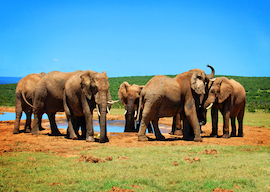
April 19, 2019

Source: BIgstock
The African elephant issue is an extremely complex and divisive one, drawing attention from around the globe. Right now, the argument over whether or not to reopen safari hunting is fracturing the Botswana political establishment at the highest level as a presidential election looms. In a nutshell the problem is there are either too many of these wonderful animals in some areas or way too few, and each situation presents with different dynamics and few easy answers. Against this backdrop, it was with a measure of dismay that I reacted to the recent headline news regarding the explosive debate over whether to cull elephant or not cull them.
We here in Africa have been informed that a U.S. poll, conducted by the Remington Research Group for Humane Society International (HSI), revealed that three in four respondents considered it important to protect elephants from trophy hunting, 78% did not support the proposed culling (in Botswana), and 73% believed that if trophy hunting and elephant culls were started, Botswana’s image as a leader in wildlife conservation would be harmed.
What this tells us is that expert opinion based on the best available empirical research and pragmatic efforts to address very pressing wildlife- and human-related problems is now marginalized by American opinion makers. It would be of some relief if we were to believe the respondents in this poll were well-informed of the details relating to this difficult discussion, but I very much doubt that is the case. Just as millions of people have jumped to conclusions, without understanding the science or contributing factors, on the alleged threat of “global warming,” so does a poorly informed majority leap onto the anti-hunting bandwagon, which millions rode with such gay abandon when the virtue signalers of the world went apoplectic over the shooting of “Cecil the Lion.” Clearly, being anti-hunting in any shape or form is the fashionable place to be, so few take the trouble to try to understand the problem better, while fewer still have the gumption to dissent from the popular view when exposed to the facts. But what is even more infuriating is the fact that these people who are so happy to pass judgment then appear to have little or nothing to offer as a practical alternative solution.
In the modern era, one of the most successful African conservation stories is ongoing in southern Zimbabwe on the Bubye Valley Conservancy, which is an 800,000-acre property reserved entirely for controlled hunting. As a result of the Cecil the Lion debacle, the lion population has multiplied to the point that it has to be reduced because it is threatening the species diversity of the area, and without hunters, the management is struggling for a solution. True to form, the owners have reached out to the anti-hunting community and asked for their assistance in removing and accommodating the surplus cats, but their pleas, I gather, have fallen on deaf ears.
For anyone seriously concerned with the welfare of the people, the environment, and the wildlife of southern Africa, they would be startled by the statistics that cry out for serious attention and a realistic reaction. Amid all the hysteria about elephant, few bother to remind themselves that real conservation requires the protection and maintenance of all plant and animal species diversity, not just elephant. And elephants have a greater propensity to damage their environs than any other mammal, particularly when their numbers exceed the carrying capacity of their range. Simply put, other forms of life must pay a heavy price to accommodate a surplus elephant population.
While human populations and the concomitant demand for land continue to grow in both Botswana and Zimbabwe, so are their elephant numbers. One estimate coming from the Zambezi Society puts the elephant population of what is now known as Zimbabwe at a paltry 4,000 in 1900, when the country was very sparsely populated. Against a backdrop of a massive increase in the number of people, there are now over 80,000, and that is despite the culling of roughly 45,000 between 1960 and 1990.
Hwange National Park, which is now home to the bulk of the Zimbabwean elephant population, did not boast a permanent elephant presence until the arrival of the Europeans at the turn of the last century. They were at a loss as to what to do with an uninhabited wasteland unsuited to agriculture because of poor sandy soils and a lack of water. A farsighted decision was made to turn it into a viable wildlife refuge through the creation of artificial water holes drawing on subterranean water, and the success was spectacular; too successful, in fact, and thus the present-day problem of too many animals.
Neighboring Botswana, part of the same ecosystem, and about which the present controversy swirls, is home to approximately 130,000 elephants, the largest population of them in Africa, and parts of the country, particularly the Chobe area, are being ecologically devastated as a result of the overconcentration of animals.
The important question that should have been asked of the people polled by the Remington Research Group is simple: You don’t like culling and you don’t like hunting, so will you personally contribute financially to the only alternatives, which are very costly; possibly sterilization or the purchase of new land prior to capture and relocation? I suspect most of these people are liberals, and like most liberals, they are famous for having great ideas but always looking for someone else to pay for them. While they waffle on, a man-made ecological disaster is unfolding.